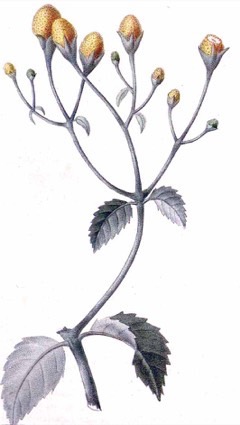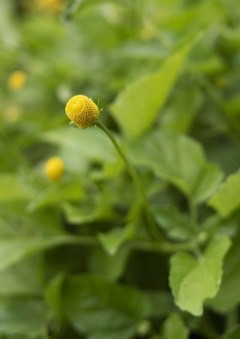 |
|
|
 |
| wikimedia.org Sixflashphoto |
Translate this page:
Summary
Physical Characteristics

 Acmella oleracea is a PERENNIAL growing to 0.4 m (1ft 4in) by 0.4 m (1ft 4in) at a fast rate.
Acmella oleracea is a PERENNIAL growing to 0.4 m (1ft 4in) by 0.4 m (1ft 4in) at a fast rate.
See above for USDA hardiness. It is hardy to UK zone 10 and is frost tender.
Suitable for: light (sandy), medium (loamy) and heavy (clay) soils and prefers well-drained soil. Suitable pH: mildly acid and neutral soils. It cannot grow in the shade. It prefers moist soil.
UK Hardiness Map
US Hardiness Map
Synonyms
Anacyclus pyrethraria (L.) Spreng. Bidens acmelloides Berg. Bidens fervida Lam. Bidens fixa Hook.f. Bidens fusca Lam. Bidens oleracea (L.) Cav. ex Steud. Cotula pyrethraria L. Pyrethrum spilanthus Medik. Spilanthes acmella var. oleracea (L.) C.B.Clarke. Spilanthes acmella var. oleracea (L.) C.B.Clarke ex Hook.f. Spilanthes fusca hort.par. ex Lam. Spilanthes oleracea L. [Illegitimate] Spilanthes oleracea var. fusca (Lam.) DC. Spilanthes oleracea var. oleracea. Spilanthes radicans Schrad. ex DC. [Illegitimate].
Plant Habitats
Edible Uses
Edible Parts: Leaves Oil
Edible Uses: Oil
Leaves - raw or cooked [46 , 301 ]. Adds a pungent flavour to salads that stimulates the salivary glands whilst having a numbing effect on the tongue and lips [301 , 348 ]. Eating the leaves is a memorable experience. They have a smell similar to any green leafy vegetable. The taste, however, is somewhat reminiscent of Echinacea, but lacking the bitter and sometimes nauseating element of that plant. First, a strong, spicy warmth spreads outward across one's tongue, turning into a prickling sensation. With this the salivary glands leap into action, pumping out quantities of saliva. As the prickling spreads, it mellows into an acidic (slightly metallic) sharpness accompanied by tingling, and then numbness. The numbness fades after a time (two to twenty minutes, depending on the person and amount eaten), and the pungent aftertaste may linger for an hour or more [372 ]. A very popular ingredient in Amazonian soup dishes, and has become the favourite vegetable for Europeans living in Madagascar [301 ]. A concentrated extract of the plant, sometimes called jambu oil or jambu extract, is used as a flavoring agent in foods, chewing gum, and chewing tobacco. It is described as having a citrus, herbal, tropical or musty odor, and its taste can be described as pungent, cooling, tingling, numbing, or effervescent.
References More on Edible Uses
Medicinal Uses
Plants For A Future can not take any responsibility for any adverse effects from the use of plants. Always seek advice from a professional before using a plant medicinally.
Analgesic Anthelmintic Antibacterial Antifungal Antiinflammatory Antirheumatic Dysentery Malaria
Sialagogue Tonic
The most common and widespread medicinal use is to treat toothache and throat and gum infections [299 ]. Worldwide the flower heads are used either fresh or dried and powdered, but the use of roots and leaves has been recommended as well [299 ]. The plant is further recommended as a cure for dysentery and rheumatism, and to enhance the immune system. It is used against blood parasites, especially against malaria, both prophylactic and curative [299 ]. The leaves are sialagogue [348 ]. The leaves and flower heads are analgesic, anthelmintic, antibacterial and antifungal [372 ]. Some of the medicinal compounds are destroyed by desiccation or freezing [372 ]. In-vitro studies have shown strong antibacterial activity against Escherichia, Klebsiella, Proteus, Pseudomonas, Salmonella and Staphylococcus. Also Candida albicans is inhibited [299 ].
References More on Medicinal Uses
The Bookshop: Edible Plant Books
Our Latest books on Perennial Plants For Food Forests and Permaculture Gardens in paperback or digital formats.

Edible Tropical Plants
Food Forest Plants for Hotter Conditions: 250+ Plants For Tropical Food Forests & Permaculture Gardens.
More

Edible Temperate Plants
Plants for Your Food Forest: 500 Plants for Temperate Food Forests & Permaculture Gardens.
More

More Books
PFAF have eight books available in paperback and digital formats. Browse the shop for more information.
Shop Now
Other Uses
Containers Cosmetic Cut flowers Insecticide Oil
Use as an natural insecticide has proved effective against yellow fever mosquito (Aedes aegypti) and corn earworm moth (Helicoverpa zea) larvae. [299]. Used widely as an ornamental because of the attractive colourful heads[299]. Attracts fireflies when in bloom. Jambu extract can also be used in cosmetics and shampoos. Flowers are good for cutting, drying and preserving. This plant is attractive to bees, butterflies and/or birds. Suitable for growing in containers.
Special Uses
Attracts Wildlife Food Forest
References More on Other Uses
Cultivation details
Prefers moist, well-drained, black (high organic content) soil. Prefers a sunny position[200]. Tolerates part sun to full sun. It grows in regions with an average temperature of 26°C. The rainfall is 2,700 mm per year. The relative humidity is 85%. It is damaged by frost. Soil pH requirements: 6.1 (mildly acidic) to 7.5 (neutral). Plants have escaped from cultivation in New Caledonia, where the species is classified as 'Invasive'[305]. There is a wild form with much stronger flavoured leaves that is occasionally used in salads but is more commonly used medicinally, especially to treat toothache[301, K]. A cultivated form 'Oleracea' has milder flavoured leaves and has become very popular in Brazil both as a salad and an addition to soups[301].
[1-4]. In garden design, as well as the above-ground architecture of a plant, root structure considerations help in choosing plants that work together for their optimal soil requirements including nutrients and water. The root pattern is rhizomatous with underground stems sending roots and shoots along their length. Bloom Time: Mid Summer to Early Fall. Blooms repeatedly.
References Carbon Farming Information and Carbon Sequestration Information
Temperature Converter
Type a value in the Celsius field to convert the value to Fahrenheit:
Fahrenheit:
The PFAF Bookshop
Plants For A Future have a number of books available in paperback and digital form. Book titles include Edible Plants, Edible Perennials, Edible Trees,Edible Shrubs, Woodland Gardening, and Temperate Food Forest Plants. Our new book is Food Forest Plants For Hotter Conditions (Tropical and Sub-Tropical).
Shop Now
Plant Propagation
Seed - requires a temperature of 21°c to germinate[299]. Germination takes place in about 2 weeks[423]. Cuttings when the plant is not in flower[299].
Other Names
If available other names are mentioned here
Toothache plant, paracress, Sichuan buttons, buzz buttons, tingflowers, electric daisy. An-ka-sa-kir, An-sa-te, Berro, Berro de Para, Borousni, Brede mafane, Cresson de Para, Ibouoni, Jambu, Marsang, Marshang, Motum mersh, Oubouonou, Phak khrat, Rasun sak, Tipebouoti, Toothacheplant, Yoritampobou [1-4].
Native Range
Coming Soon
Weed Potential
Right plant wrong place. We are currently updating this section.
Please note that a plant may be invasive in one area but may not in your area so it's worth checking.
None Known
Conservation Status
IUCN Red List of Threatened Plants Status : Not Listed.

Growth: S = slow M = medium F = fast. Soil: L = light (sandy) M = medium H = heavy (clay). pH: A = acid N = neutral B = basic (alkaline). Shade: F = full shade S = semi-shade N = no shade. Moisture: D = dry M = Moist We = wet Wa = water.
Now available:
Food Forest Plants for Mediterranean Conditions
350+ Perennial Plants For Mediterranean and Drier Food Forests and Permaculture Gardens.
[Paperback and eBook]
This is the third in Plants For A Future's series of plant guides for food forests tailored to
specific climate zones. Following volumes on temperate and tropical ecosystems, this book focuses
on species suited to Mediterranean conditions—regions with hot, dry summers and cool, wet winters,
often facing the added challenge of climate change.
Read More
Expert comment
Author
(L.) R.K.Jansen
Botanical References
Links / References
For a list of references used on this page please go here
A special thanks to Ken Fern for some of the information used on this page.
Readers comment
| Add a comment |
|
If you have important information about this plant that may help other users please add a comment or link below. Only comments or links that are felt to be directly relevant to a plant will be included. If you think a comment/link or information contained on this page is inaccurate or misleading we would welcome your feedback at [email protected]. If you have questions about a plant please use the Forum on this website as we do not have the resources to answer questions ourselves.
* Please note: the comments by website users are not necessarily those held by PFAF and may give misleading or inaccurate information.
To leave a comment please Register or login here All comments need to be approved so will not appear immediately.
|
Subject : Acmella oleracea
|
|
|
|